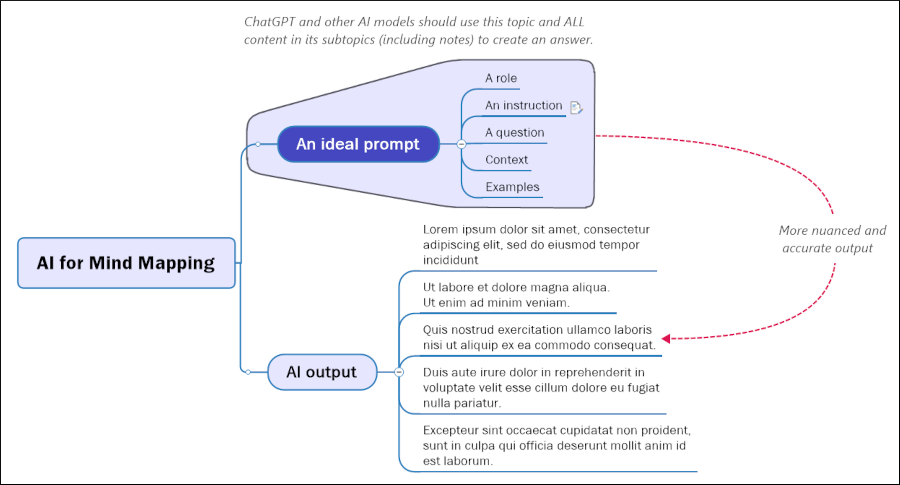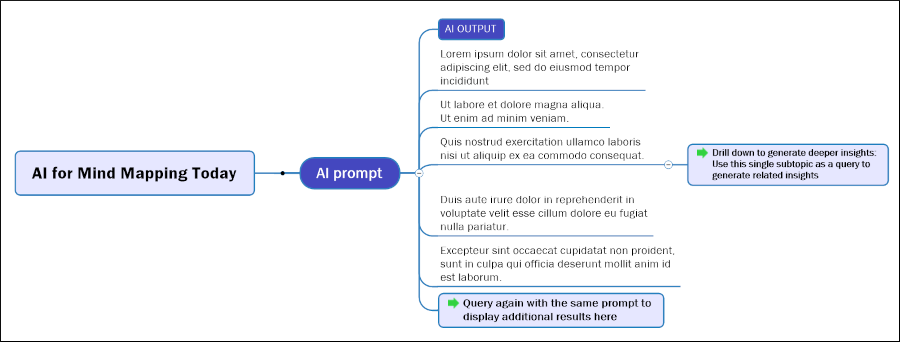
The more you learn about AI, the more you probably realize that you’ll never get the results you’re looking for from AI if you simply give it a one-sentence prompt.
In order to get an accurate, nuanced response, you must instead provide it with context and guidelines on the type of style and voice in which you want it to answer. Background information is also valuable to help guide the intelligent agent to the types of information and ideas you seek.
It’s easy to do this in ChatGPT or other AI tools that provide a text input box where you can load up the AI with a series of prompts before telling it to go to work on your behalf. As we’ll see in a moment, it’s not as easy to do in today’s mind mapping tools. But a solution isn’t far away.
But first, let’s take a closer look at prompting, in case you’re not familiar with this concept.
What are AI prompts?
Prompts are the instructions that you give to ChatGPT or another AI model. Think of a search engine query, except stated in complete sentences or well-structured questions. It uses one or more prompts to search its gargantuan resources (the collective knowledge of a larew portion of the internet) to assemble and display its answers.
But the AI engine can’t guess at the content or intent of your query. If your prompt isn’t very specific, its answers will likewise be very general and may not meet your needs. You need to provide it with additional information. Fortunately, most AI tools enable you to “daisy chain” prompts together before telling the AI agent to process your query.
What kind of information should you feed it? How should you structure AI prompts for best results? According to learnprompting.org, there are five main parts to an effective AI query:
- A role
- An instruction/task
- A question
- Context
- Examples
Roll: Roll prompting instructs the AI tool use a certain persona or point of view when answering your question. It can often help the AI engine to frame its response in a way that is more useful to you. For example, you could ask ChatGPT to answer your question from the point of view of a brilliant mathematician, a marketing expert or a customer service representative. Each one will produce different results.
Instruction/task: Instruction prompting consists of giving the AI tool some task or set of direction. Although the concept is simple, ChatGPT and other AI tools are able to follow surprisingly complex instructions.
Context: This is any relevant information that you want the AI tool to use when answering the question or carrying out the instructions you’ve provided.
Examples: Often, you can improve the results of your AI tool’s output by providing it with several examples of the type you’re seeking.
The current state of AI-enhanced mind mapping tools
Unfortunately, mind mapping software is not at this stage of maturity. The AI agents of today’s mind mapping software are designed to utilize a single topic as a prompt. Is there any surprise, then, that the results you get back are overly general?
Several of these tools enable you to pick an AI-generated topic and ask the tool to dig deeper. But this is not the same as providing it with a multi-faceted, nuanced set of inputs – similar to the 5-step model we just reviewed – to guide its output.
A better model for AI-enhanced mind mapping
Here’s how it should ideally work:
Step 1: create a topic that generally describes the challenge you want AI to address.
Step 2: Add sub topics that provide ChatGPT with the necessary background and context it needs to accurately answer your question.
Step 3: Launch your query. When you do so, the integrated AI tool should consider not only your initial topic but also all of the content in the sub-topics that are connected to it. Ideally, it would be nice if such a tool would also be able to read and interpret attached topic notes, too.

As you can see from the model I’ve constructed, a mind map is actually a simple and elegant way to organize detailed AI queries. Rather than making up a series of ad hoc prompts and entering them into the text box of your favorite AI tool, you could actually organize your thinking using a mind map and refine and improve it before conducting your query. When you launched it, it would consider ALL of your carefully constructed mind map based prompts – not just a single topic or subtopic.
I don’t think this is asking for too much. It shouldn’t be too hard for a software developer to program this type of functionality into their mind mapping applications.
This approach could make a significant difference in the quality of output from ChatGPT in mind maps.
What do you think?


Leave a Reply